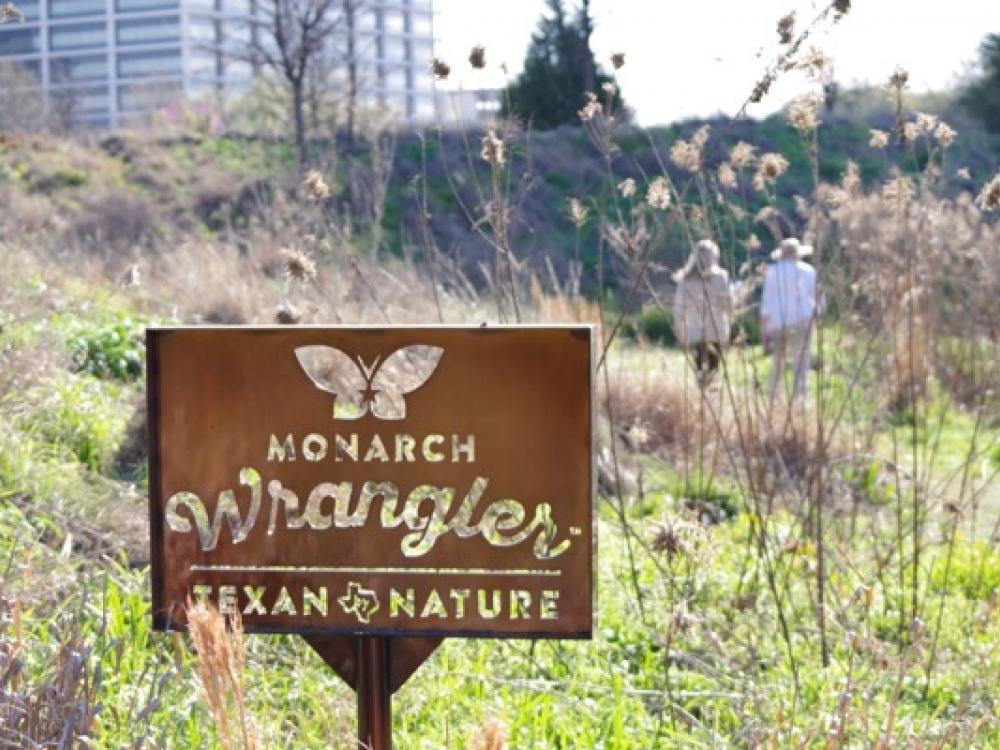
The restored prairie at the George Bush Presidential Library in Dallas provides wildlife habitat for native species. Photo by Scooter Smith.
May 27, 2019
A Dallas-based landscape architect has some wild ideas about urban planning.
According to Kevin Sloan, a city planning expert and UT Arlington professor, Dallas-Fort Worth could be transformed into a first-of-its-kind urban/rural hybrid, where people, bees, birds, butterflies and bobcats all thrive together.
He says all it would take is a little tweaking of city ordinances and property tax code across the 13-county region.
The concept is known as rewilding. Essentially it's the practice of returning domesticated land back to a natural state. Artfully landscaped with native trees, natural grasses and wildflowers, these rewilded spaces are as much of an environment for people as they are for the native wildlife that would flock to them, Sloan says.
“Rewilding is a new approach to designing the space between buildings that’s sweeping the world,” Sloan says. “It's something that can become part of just about any landscape project, either newly proposed or existing. And it really presents a very attractive set of benefits to individuals and this is why it's being so rapidly embraced by so many places and cities around the world.”
 A xeriscaped lawn in suburban Fort Worth. Photo by Julie Thibodeaux.
A xeriscaped lawn in suburban Fort Worth. Photo by Julie Thibodeaux.
WHERE THE WILD THINGS ARE
Rewilding goes far beyond simply substituting native plants and grasses for exotic varieties in a landscape, a practice known as xeriscaping. Xeriscaping saves resources and requires less maintenance, but it alone is inadequate for creating a habitat that can sustain a wide variety of insects, birds and mammals, says Sloan. What's needed is a more comprehensive plan.
“Most people have observed that there's been recently a flourish in an interest for quote unquote, native plantings, which is good. Native plants typically use much less water than cultivated landscape materials like turf grass or certain species of ornamental shrubs and trees that typically get pruned and sheared into places and spaces that look like English gardens, if not golf courses,” says Sloan. “And what rewilding is, is it’s the next step beyond native plants. A native planting project is good in that it saves water, but it's not a rewilding project - yet - because even though the native [plants] are known to attract [wild species], the butterflies and the migrating songbirds and the other species that could inhabit a landscape haven't been consciously thought about as a prediction for that landscape design.”
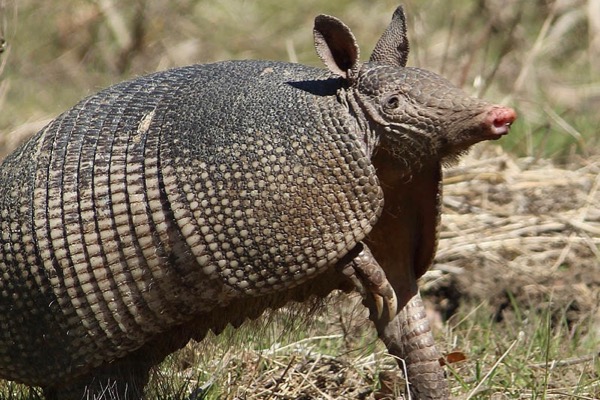 Armadillo foraging at River Legacy Park in Arlington. Photo by Chris Jackson of DFW Urban Wildlife.
Armadillo foraging at River Legacy Park in Arlington. Photo by Chris Jackson of DFW Urban Wildlife.
So the rewilding process focuses on the wildlife that it’s intended to accommodate, like fireflies, screech owls or red foxes, and then explores how to design a landscape to make a good home for them, with room to raise up a brood and plenty of food sources.
But if you're imagining a dangerous, untamed landscape with buildings, Sloan says a rewilded DFW wouldn't exactly be an overgrown wilderness ruled by wildlife. It's very much like the area is now, but with corridors of natural landscapes and pockets of prairie here and there.
Sloan says, a rewilded city still has plenty of sculpted, mowed and irrigated areas around homes, buildings and public areas just like the typical yards seen everywhere today. The only difference is that city planners would evaluate the whole of how land is being used and find places where everyone would be better served by turning over a number of the easements, unusable land fragments, housing addition detention ponds and spaces between buildings back to a natural state. The goal would be to put natural landscapes within walking distance of everyone.
“These [areas] are given over to an approach that won’t be mowed or look like a golf course or an English yard. They'll turn into something that might look like prairie grasses and re-establish a kind of natural ecology that is much lighter on water use, much lower in maintenance costs and so forth. And they all become habitat for species to beneficially use,” Sloan says.
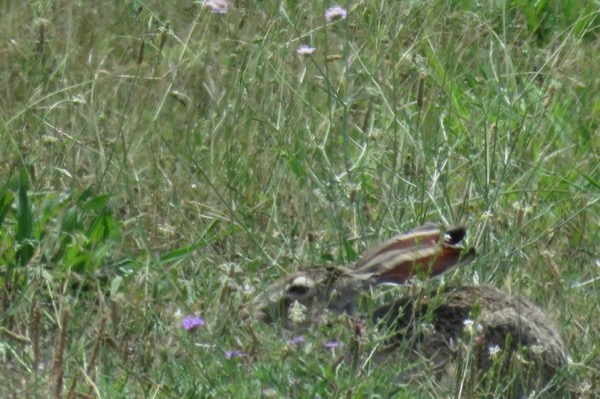 A jackrabbit in Dallas County. Courtesy of Chris Jackson of DFW Urban Wildlife.
A jackrabbit in Dallas County. Courtesy of Chris Jackson of DFW Urban Wildlife.
City and regional planners would look at what species are considered desirable to attract and which species we’d rather avoid, Sloan says. Bees and butterflies, songbirds and migratory fowl, bobcats and even coyotes all get along well with humans as do hawks, owls, eagles and kestrels, but, not alligators. Alligators will have to stay in Houston.
Some areas, maybe near a school or a nursing home, might be built up with milkweed and wildflowers solely to help monarch butterflies. Other large, remote areas might be given over as habitat for some of the area’s top predators to live free and wild - symbols of the state's collective renegade attitude.
“This rewilding process begins with an evaluation of species we want to attract, because not all species are appropriate. There are some species that are beneficial and desirable, and there are others that might want to be resisted by how you shape the planting program. After that program of natural life and non-human species is formulated, then that drives the selection of the plants. The plants that are selected have their own relationships that need to occur so that the rewilding is accomplished. And then basically, human activity is reintroduced in the same design exercise with the rewilded landscape so that both of us, ourselves and our non-human friends, can coexist beneficially. That’s essentially a rewilding project,” Sloan explains.
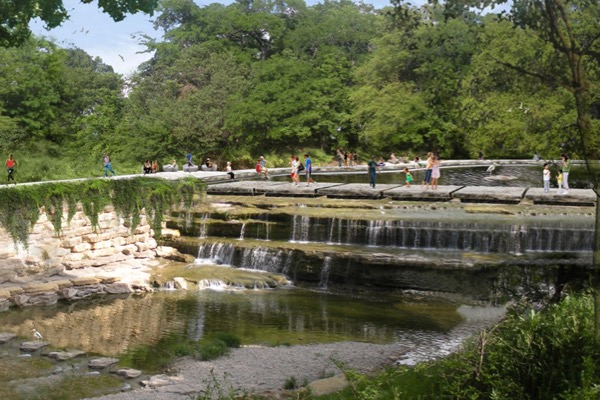 The natural falls in Airfield Falls Conservation Park in Fort Worth. Courtesy of Kevin Sloan Studio.
The natural falls in Airfield Falls Conservation Park in Fort Worth. Courtesy of Kevin Sloan Studio.
WALK ON THE WILD SIDE
Through his private practice, Kevin Sloan Studio, which is primarily known for urban planning, space making and landscape architecture, Sloan has already put the rewilding theory into practice, designing a variety of projects in North Texas that serve as samples of what's possible everywhere. One of his latest designs is the redesign of the Airfield Falls Conservation Park in Fort Worth. The small park, located next to the Naval Air Station Joint Reserve Base, features a trail that connects to the Trinity River Trails.
“The Airfield Falls Conservation site is probably the most textbook demonstration of what a rewilded landscape can look like with architecture being a part of it. You arrive in a front part and there's a water harvesting parking lot. And there's a jet aircraft display because it's very close to [the Naval Air Station Joint Reserve Base] and then you move down a trail along the butterfly plant installation to what is in effect, the tallest natural waterfall in North Texas. That's the whole point of the park - to provide public access to this waterfall. And it'll show you the many different faces of how rewilding can literally be the waterfall which we left untouched - we didn't do anything to the waterfall. We didn't build overlooks. Frank Lloyd Wright built a house over a waterfall. We didn't do anything. We just left it untouched. So you're lead to it on a path and you have to walk across the grasses to finally get to it just like everyone has had to get to it since the beginning of time in this part of North America. And then in the front with a car park, there's architecture; there's picnic shelters for families and group gatherings. And there's this particular jet aircraft display that we worked out and engineered with the firm called Datum Engineering,” Sloan says.
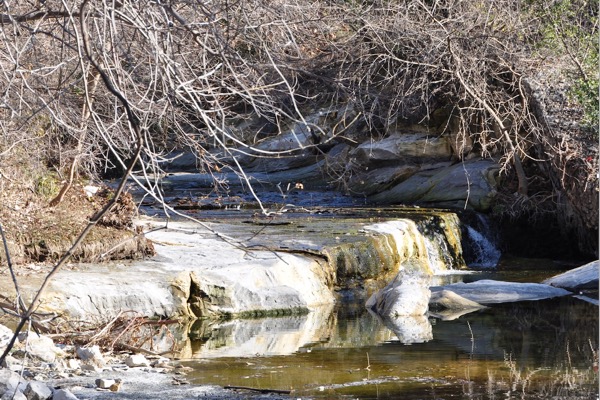 A creek at Vitruvian Park was left in its natural state. Courtesy of Kevin Sloan Studio.
A creek at Vitruvian Park was left in its natural state. Courtesy of Kevin Sloan Studio.
Vitruvian Park in Addison is another project of Sloan’s. For the project, part of the creek was left untouched and rewilded with native plants added, while half the creek was turned into a multifunctional park.
“And now they've added a Christmas lighting festival that attracts a significant number of cars and people every weekend during the holiday season. So, I use those as examples of how nature and landscape can foster density and urban concentrations of buildings - where they're connected and they're woven into each other as well as with nature,” he said.
Sloan said the projects demonstrate that a little rewilding can go a long way to support native wildlife.
“Every time we have done one of these environments like Airfield Falls Conservation Park, with the butterfly garden that we did there, the butterflies showed up so thick, you had to brush them away from your face. And then the turkey showed up to chase after the butterflies, and bobcats showed up to chase after the turkeys. This was an epiphany to us when it occurred - in the realization that there is a new way that we can design landscapes and environments to really account for all this.”
 A walkway runs through the restored prairie at the George Bush Presidential Library in Dallas. Photo by Scooter Smith.
A walkway runs through the restored prairie at the George Bush Presidential Library in Dallas. Photo by Scooter Smith.
HEALTHIER CITIES
Environmentalists, nature lovers and outdoorsy types would enjoy a rewilded DFW sure enough, but there’s a sizeable part of the population that might just ask - why we should even bother with making our urban existence a little more in tune with nature, especially if there’s tax money involved?
Sloan answers this contention first by demonstrating that a rewilded city is less prone to the kind of flooding that we’ve seen recently in Austin and other parts of Texas. Coarse, permeable paving materials that are part of a rewilded project along with large, grassy areas help to absorb stormwater and keep it from pooling up and needing somewhere to go. Also, wherever there’s a mass of vegetation rather than concrete or asphalt, you’ll find a cooling effect that helps to moderate summertime temperatures, and it cleans the air. Prairie grasses also help to recharge groundwater with roots that run sometimes 16 feet deep. Bobcats, owls and coyotes can keep rodents from reaching plague-like numbers. A single bat can eat as many as 1,000 mosquitoes in just an hour.
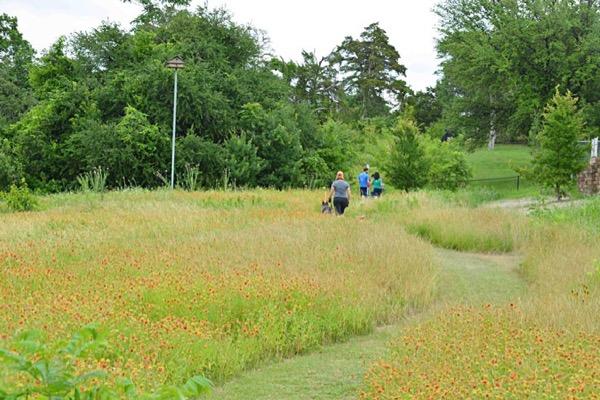 Twelve Hills Nature Center in Dallas is a restored prairie and outdoor learning center where a rundown apartment complex once stood. Courtesy of Twelve Hills Nature Center.
Twelve Hills Nature Center in Dallas is a restored prairie and outdoor learning center where a rundown apartment complex once stood. Courtesy of Twelve Hills Nature Center.
NATURE PRESCRIPTION
These are direct benefits that we can all take advantage of, but Sloan makes his strongest case for why we should rewild by citing the revolutionary research of Dr. Frances Kuo who demonstrates that no matter who you are or what your attitude about nature is, you’re not feeling your best without an outdoor experience.
“Get ready for Vitamin N,” Sloan says. “What we are seeing now, we being academics, individuals interested in finding solutions, is that a group largely of academics who have been doing about three decades worth of peer-reviewed research are now producing unassailable evidence that human contact with nature essentially produces measurable health benefits - and these benefits are extraordinary.
"A group largely of academics who have been doing about three decades worth of peer-reviewed research are now producing unassailable evidence that human contact with nature essentially produces measurable health benefits - and these benefits are extraordinary."
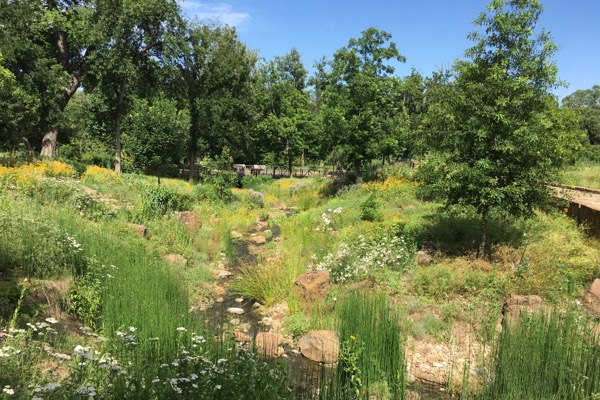 Native prairie restoration at Fort Worth Botanic Garden. Photo by Julie Thibodeaux.
Native prairie restoration at Fort Worth Botanic Garden. Photo by Julie Thibodeaux.
“They are discovering that human contact with nature can facilitate the lowering of obesity, because your metabolism accelerates through the contact. It will improve diabetes related to obesity. It will suppress clinical depression - [there are] cases after cases of individuals suffering from depression, that additional contact with nature actually cured them to a great extent. It can relieve anxiety disorders. It can improve your cardiovascular health because of all the blood pressure related things. But here's the real kicker: they've actually measured now that human contact with nature - not even an excessive level; it's just a frequent couple times a week - can boost the production of white blood cells that have the capability to attack and preempt early forms of cancer from taking hold. This is significant. If you want to say, well what are all these prairie grasses and all this rewilding - these are all [just] romantic ideas. But the real bottom line is they’re making us healthier.
ECONOMIC VALUE
And Sloan said, if that's not enough of a bottom line, the Wall Street Journal has recently published articles showing the economic and real estate production enabled by reestablishing these natural environments.
“These are real benefits. And this is the moment when I'm lecturing or I'm talking to a crowd that the crowd gets very quiet. Because at first, there's a skepticism, and we should be skeptical of a lot of stuff out there. I can tell the crowd is assessing me as a romantic or a tree hugger, whatever, talking about butterflies and all this. And then suddenly I produce all this statistical information about the measured economic benefits - these are not just approximate. These are legitimate peer-reviewed studies. Between that and the health benefits researched by Dr. Kuo and her research colleagues, it’s truly extraordinary - it’s unassailable. Those that want to disagree are doing so at their own peril and certainly the peril of future generations.”
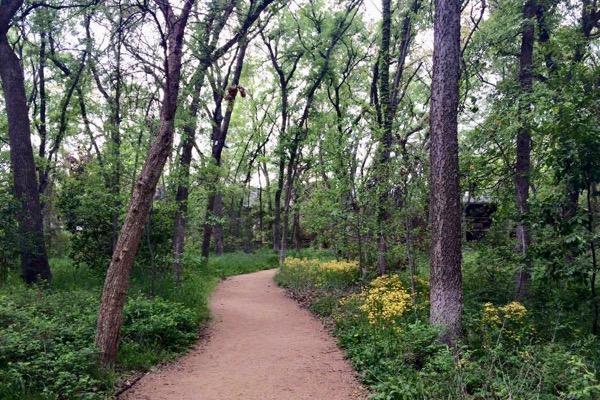 A wooded trail at River Legacy Park in Arlington. Courtesy of city of Arlington.
A wooded trail at River Legacy Park in Arlington. Courtesy of city of Arlington.
RIPE FOR REWILDING
But why is the North Texas region especially prime for rewilding? Sloan says it all comes down to our population density. The DFW metropolitan area includes 13 counties that stretch from Ellis County on the south up to Denton County on the north side, and about a half-hour drive both east of Dallas and west of Fort Worth, which adds up to about six million acres. When you average out the area’s population (7.5 million) over that amount of land, you find that there’s almost one acre per person. Compare that to Boulder, Colorado’s metropolitan area at almost five people per acre, and you see that we’ve got a lot more room than a city whose visitors and conventions bureau touts the region’s natural beauty in all its brochures. In fact, compare the North Texas metropolitan region to just about any other in the world, and the results are about the same.
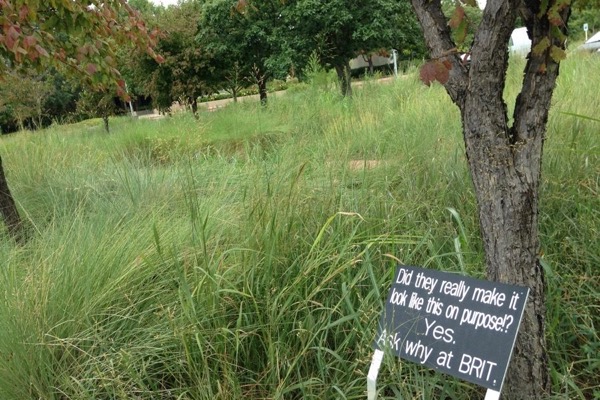 The parking lot at the Botanical Research Institute of Texas in Fort Worth features native landscaping. Photo by Karl Thibodeaux.
The parking lot at the Botanical Research Institute of Texas in Fort Worth features native landscaping. Photo by Karl Thibodeaux.
MAKING NORTH TEXAS WILD AGAIN
So, Sloan says North Texas stands at a crossroads of sort where the city planners throughout the region can bring back some of the beauty and ecological benefits of the prairie that we’ve built our cities upon and make sure nature doesn’t become something outside of our city experience, as if we’re hemmed into medieval-like cities with walls separating us from the beauty outside. Our planning and ordinances, and tax codes can be revised with a few tweaks here and there to entice rewilding to happen all over.
First, he says, we need to overhaul city and county mowing ordinances. Wildflowers and prairie grasses grow a little taller than the tops of our shoes, and some places - not everywhere, just some need to be freed up so wild plants can do their thing without the threat of the mower. Homeowners associations will need some persuading, but a good presentation of the benefits of rewilding along with some tax benefits should crack open a few minds.
Second, cities can reward developers who plan rewilding projects for their developments. For example, Sloan sees a fast-tracking of building permits whenever housing addition detention ponds are designed as a prairie setting rather than an irrigated and sculpted English garden; policies like this would excite developers to jump onboard with the idea.
Tax codes too could reward landowners who commit a certain percentage of their property to wildlife habitat and rewilding projects, just like how farmers now are rewarded with a cheap tax bill for turning prairies and forests into production grounds for crops and cattle - the opposite of rewilding.
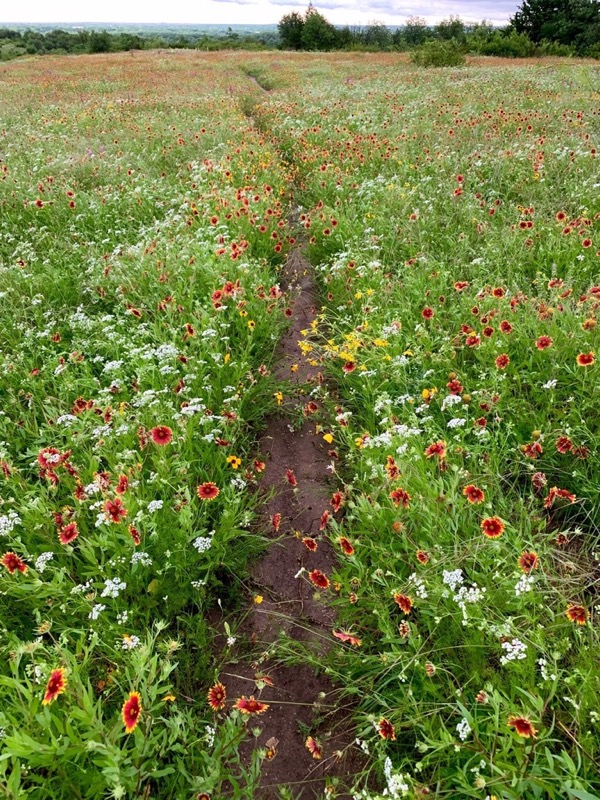 Tandy Hills Natural Area in Fort Worth is a prairie remnant preserved by the city. Photo by Don Young.
Tandy Hills Natural Area in Fort Worth is a prairie remnant preserved by the city. Photo by Don Young.
PRAIRIES IN PERIL
Sloan says that less than one tenth of one percent of the tallgrass prairie habitat of North Texas remains untouched. The rest has been turned under by the plow, mowed into oblivion or buried beneath concrete.
“The DFW footprint has almost completely obliterated an entire ecosystem. But, in the interstitial spaces that are between our buildings, there's an opportunity to recover some ground and rewild some of these areas - stop mowing them, like they're Anglican gardens and golf courses and rewild the spaces for all of the aforementioned benefits ecologically, culturally, economically, and certainly, environmentally,” Sloan says.
“We're at a point here where we can ask ourselves, are we going to do to the prairie what we did to the passenger pigeon, which used to be so prolific, they would darken the sky for hours as flocks would pass overhead? Or, could we reconstruct the prairie not just out of a romance [for natural landscapes], but combine conservation with design and begin to bring back the performative benefits of a material that can help us with our climate and CO2 issues - help us with some of our problems with songbirds and songbirds extinction - the question of what's going on with honeybees and so forth, and also produce environments that are beautiful, absolutely spectacular as anyone can see from the few examples that remain.”
Sloan understands if the concept will take some consideration before it’s accepted. He was once a young architect whose mind was fascinated with only steel, glass, mortar and stonework. His idea of an ideal city was Rome, or maybe Florence. But it was a question that kept popping up more recently in public forums where he’d speak and in the classroom that got him into rewilding. People wanted to know what his idea of a Dallas Trinity Park would look like. He didn’t have an answer he felt good about, so one day he decided to drive out to the river, find a spot and just think.
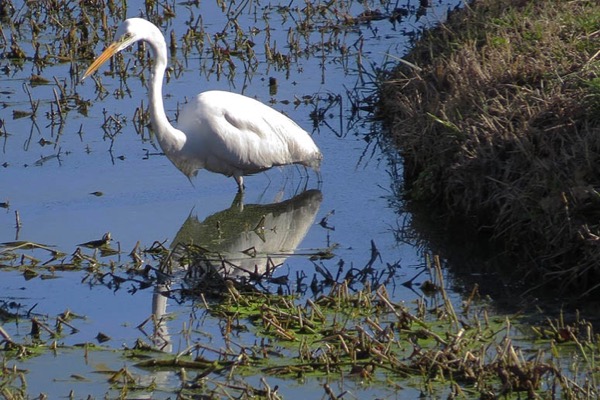 A Great Egret at White Rock Lake Park in Dallas. Photo by Chris Jackson, DFW Urban Wildlife.
A Great Egret at White Rock Lake Park in Dallas. Photo by Chris Jackson, DFW Urban Wildlife.
“Standing on the bridge and sidewalk, I looked over the Trinity. Directly below, an egret waded slowly through a shallow pool, pulling one trapped fish after another out of the fish-trap pond. “And I thought, could the answer really be that easy? Perhaps the idea of making the Trinity park a work of architecture, a work of landscape architecture or land art, is completely the wrong idea. The wrong discipline. The wrong set of tools and priorities. Perhaps it should simply be a nature project. A work of biology and horticulture. Not art. What would Dallas have and become if the entire Trinity floodway was remade into a nature project?”Sloan says. “The answer: Dallas would be the only city in the world that has an arts district and a dense urban downtown within easy walking distance of wild nature that's teaming with birds, bees and butterflies. Shortly thereafter, I learned that this kind of impulse is called rewilding.”
Stay up to date on everything green in North Texas, including the latest news and events! Sign up for the weekly Green Source DFW Newsletter! Follow us on Facebookand Twitter.









